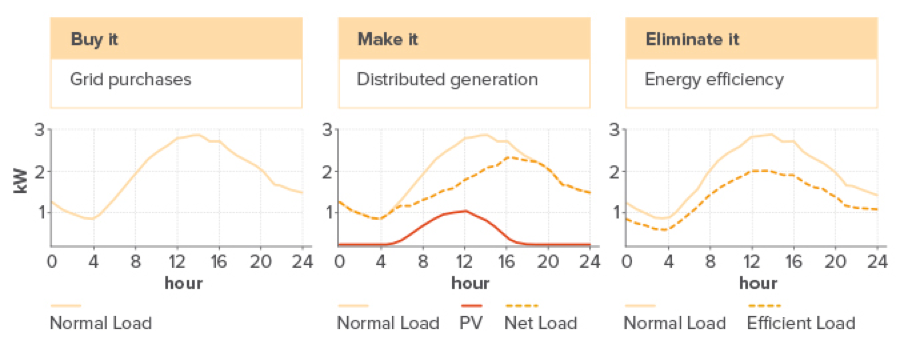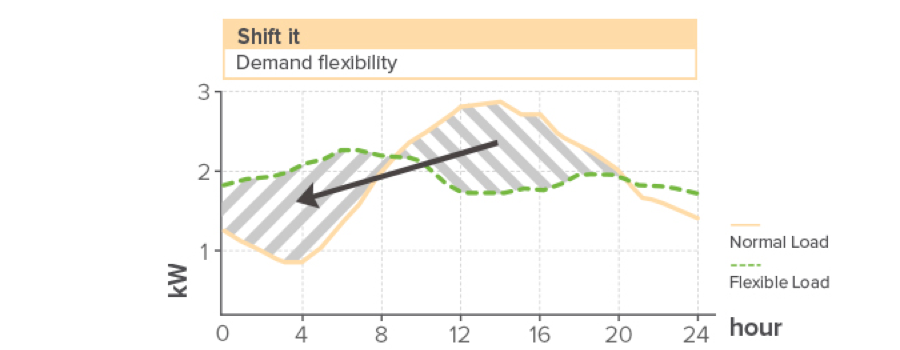This article was published in Scientific American’s former blog network and reflects the views of the author, not necessarily those of Scientific American
Buy, make, or eliminate – these are the three main ways that we have gone about meeting our electricity needs for the past century. But, according to a new report by the Rocky Mountain Institute, a rapidly growing fourth option is appearing across the country and offering a way for homeowners to decrease their monthly bills.
This fourth possibility centres on “demand flexibility” – which refers to the increasing ability for homeowners to choose when they use electricity throughout the day. Examples include delaying when water is heated after our shower in the morning to shifting when an electric car parked in the garage is charged at night.
In their report, RMI presents four graphs to show how demand flexibility differs from buying, making, or eliminating electricity use. The first graph shows what demand looks like during the day when we simply buy electricity as we need it. The middle chart shows how things look when we generate some of our electricity needs onsite with a bit of rooftop solar PV, decreasing our demand from the power grid at certain times. The chart on the right shows how energy efficiency can provide an overall reduction of total electricity demand.
On supporting science journalism
If you're enjoying this article, consider supporting our award-winning journalism by subscribing. By purchasing a subscription you are helping to ensure the future of impactful stories about the discoveries and ideas shaping our world today.

RMI (2015)
In their fourth graph, RMI shows what could happen if we were to shift our electricity demand to “off-peak” periods. That is, what if you were to do all of the things you wanted to in the day, but change when you did them (either manually, or through automatic options like time-delay settings on your washing machine). While some of your electricity demand can’t be shifted too easily – for example, to eliminate demand for electricity for lighting during a certain period would require you to either turn off your lights or install some sort of energy storage technology – there are many activities that could be shifted in time. The result of this shifting is the green dashed line shown on this graph, which is much more flat (i.e. less "peaky") than the normal load.

RMI (2015)
This flexibility is a departure from how we have historically met our electricity needs at home. While industrial facilities have long been financially incentivized to shift their demand for electricity away from “peak” demand periods, residential consumers have had little reason to shift their demand profiles. However, with the increasing availability of time-of-use pricing agreements for residential electricity consumers, more and more people are seeing an opportunity to save money by changing when they use electricity.
With time-of-use pricing structures, you pay less for electricity during periods of low demand (for example, in the middle of the night). Conversely, you pay more for a kilowatt-hour of electricity during “peak” house (for example, in the afternoon on a summer day when air conditioners are running full-speed and people are getting home from work and school). According to RMI's report, if your utility offers time-of-use rates, you could reduce your power bill by 10-40% by moving some of your peak demand to off-peak periods in this way.
In France, shifting demand from residential water heaters are currently used to reduce winter peak electricity demand by an estimated 5 Gigawatts (5%). This peak reduction is achieved by using timers and switches to shift when water is heated during the day (consumers can override this delay if they wish to). Practically speaking, this set-up means that many water heaters in France do not automatically re-heat after morning (or evening) showers. Rather, they delay reheating until lower demand periods. Given that 43% of residential electricity use in France is dedicated to water heating, this shift is no small matter.

International Energy Agency (IEA) Technology Roadmap: Energy Storage – Technology Annex (2014)
Shifting electricity demand away from peak periods has benefits for not only consumers, but also for utilities and the electricity grid:
Consumers can save money while still receiving the same service.
By lowering peak demand, utilities can avoid building “peakers” – the power plants that are only used for short periods of time to meet peak demand and then sit for the rest of the year, making them a quite inefficient asset.
Decreasing peak demand can lower the stress and strain on aging transmission and distribution infrastructure in the electricity grid.
In turn, demand shifting can be financially beneficial even for those consumers who do not have electricity time-of-use pricing options in their service areas. According to RMI, demand flexibility “can unlock $13 billion per year of avoided grid investment” meaning that consumers would presumably pay less for their electricity over time due to a decreased need for infrastructure investments. However, it would be difficult for consumers to accurately measure how this type of savings impacts their monthly electricity bill.
That being said, according to RMI’s report, roughly 65 million customers in the United States already have access to some type of time-of-use pricing agreement for their electricity use. They go on to conclude that:
“In the residential sector alone, widespread implementation of demand flexibility can save 10–15% of potential grid costs, and customers can cut their electric bills 10–40% with rates and technologies that exist today."